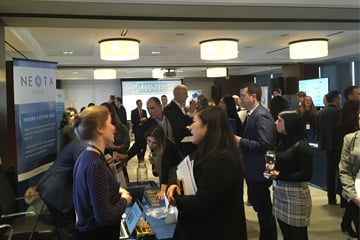
It’s not often you see a mini trade show of technology vendors set up inside one of Canada’s largest national law firms, but in an effort to show clients how it is working to innovate with the emerging legal ecosystem, Blake Cassels and Graydon LLP opened its doors to host a tech demo day last week in Toronto.

It’s not often you see a mini trade show of technology vendors set up inside one of Canada’s largest national law firms, but in an effort to show clients how it is working to innovate with the emerging legal ecosystem, Blake Cassels & Graydon LLP opened its doors to host a tech demo day last week in Toronto.
Blakes brought together its legal tech partners including Closing Folders Inc., Kira Systems, Neota Logic Inc., Blue J Legal, HighQ, Founded and Thomson Reuters to demo their technology and explain their own innovation stories for about 150 Blakes clients. But it was more than just a demo of software, it was an effort to show clients that innovation is happening at the firm in lock step with the legal tech community.
Anne Glover, partner and lead of the firm’s inSource practice, spoke about the team of about 20 lawyers at the firm who provide an alternative service delivery model to help clients with work such as document review, due diligence, commercial contract review and legislative updates. Founded in 2013, inSource lawyers use predictive coding and other forms of artificial intelligence and machine learning to do work that might otherwise be sent out to alternative providers.
“The lawyers at inSource work here, at our firm — it’s very integrated with the lawyers who know all of our clients,” said Glover.
As an example, if a client has a due diligence project, the Blakes lawyers on the team for that client will come to the inSource team, get them up to speed on the deal and then make sure daily updates occur with those lawyers.
“We provide seamless service to our clients and the goal of InSource has always been to provide excellent service,” she said. “The other benefit of having everyone here is that just when you think you’re done on a due diligence or document review project and it’s the day before closing, often, all of a sudden, there is another 200 documents to review that have to be done by 5 o’clock so the deal can close. We have the same lawyers who worked on the first part of the due diligence just waiting to do that document review and we get the job done.”
Technology plays a big role in the work of the InSource team.
“Our team uses almost every one of the programs you see here today, and in fact they hardly use anything else but these types of programs. They might use Excel once in a while, but, otherwise, they aren’t opening Word or PowerPoint; they are using these tools,” she said.
Speakers also tried to dispel some of the myths around the use of tech in law and demonstrate where it can aid in making life easier, especially for in-house clients. Glover addressed the myth that legal tech tools will eliminate jobs for some lawyers.
“You might hear in the news that these types of tools are going to take over the world and that we aren’t going to need lawyers anymore, but that is not true; you need lawyers who are smart using this technology. We’re dealing with a time when there are so many documents and without these tools we’re not going to be able to function,” she said.
Jason Moyse, a consultant to Blakes, spoke on the challenges of contract life cycle management — one of the biggest pain points for in-house counsel often viewed as a “disjointed activity” — not owned by any singular entity in an enterprise.
“Contract life cycle management is a beast because it touches the entire organization,” said Moyse. “I have empathy for anyone in-house if you are told you’re in charge of life cycle management. There can be confusion [about] which technology to use, which platform or if you are to be using multiple technologies.”
Ownership of the entire contract life cycle management is always an issue and it’s not always going to be the legal team, he said.
“Technology is not a panacea — you have to have people as part of that and give some thoughtfulness to process and then you bring in technology once you’ve taken those steps of thinking through how your people and your processes are going to work together for an ‘end-to-end solution,'” said Moyse.
His recommended Top five things to do when tackling CLM are: Unite the silos of legal, procurement, finance, IT, sales and others; know that APIs (application program interfaces) are your friend; then have a “single source of truth for master data” — put all your contracts in one spot, communication/training and feedback for continuous improvement and have executive sponsorship.